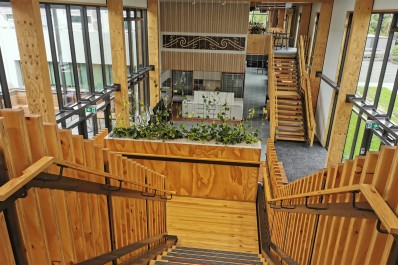Kōwhaiwhai
In this section
-
Visiting Te Rauhītanga – The Gathering Place
- Kōwhaiwhai
- A story of Haumia Tiketike – He kōrero mō Haumia Tiketike
- A story of Rongo – He korero mō Rongo
- A story of Tāne – He kōrero mō Tāne
- Carvings – Whakairo
- The names of our buildings
- The names of our meeting rooms
- Virtual reality: Karanga a Tāne Mahuta
- Rene Orchiston Flax Collection – He Kohinga harakeke nā Rene Orchiston
- Banks and Solander prints
- Invertebrate illustrations
- Biodiversity display
- Weed and predator control display
- Land video wall
- Historic soil maps
- Soil classification illustrations
- Augmented reality sandpit
- Beech tree cores
This kōwhaiwhai represents the work of Manaaki Whenua and our ambition:
Kia mauriora te whenua me tōna taiao
(Make the life-force and vitality of the land strong).

Kōwhaiwhai in the staff café
The kōwhaiwhai is a traditional Māori pattern that is used in whakairo (carving) and art to enhance storytelling. This kōwhaiwhai was designed to combine elements from four separate kōwhaiwhai designs that represent different aspects of our research: biodiversity, biosecurity, land, and environment.
The koru is life, and derives from the forest. The manawa line is the heart that connects the entire design. The spiral represents Ranginui and Papatūānuku intertwined. The notches symbolise the carving of the land – the triangles represent the peaks and valleys – and form a tāniko, or border, that can be found on traditional cloaks. The overall composition balances curvilinear shapes with rigid triangles while maintaining a natural flow and organic feel.
Manaaki Whenua worked with Hori-Te-Ariki Mataki of Ariki Creative to design five kōwhaiwhai patterns representing our research. The designs draw inspiration from Māori art and design, kōwhaiwhai, weaving, carving, and tā moko to ground the narrative for each design in traditional Māori lore and culture, aesthetics, and the environment.
Manaaki Whenua

The Manaaki Whenua pattern is a combination of elements from all the designs from each of our ambitions. The koru is life, and derives from the forest. The manawa line connects the spiral, the spiral being Ranginui and Papatūānuku intertwined. The notches symbolise the carving of the land – the triangles represent the peaks and valleys – and form a tāniko, or border, that can be found on traditional cloaks. The overall composition balances curvilinear shapes with rigid triangles while maintaining a natural flow and organic feel.
Biodiversity

This design is an adaptation of traditional koru forms, with the connecting lines representing the space for potential in our biodiversity. The koru is a symbol of new life, although the unfolding fern frond can depict an adult if there is a smaller fern connecting within.
The shapes of the fern bodies are stylised to differentiate the koru. The 'V' shapes are notches that symbolise the landscape, which in traditional stories was shaped by Maui and his brothers, who carved up the Great Fish, or locally, in Te Waipunamu, by Rākaihautū, who used a digging stick to carve up the land. The wavy line connecting the pattern together is the manawa line, the heart that connects the entire design.
Biosecurity

This design represents protection from biological threats, which is one of the responsibilities of Manaaki Whenua. Manaaki Whenua helps to protect or act as kaitiaki for the land. Kaitiaki can be depicted in the form of a Manaia (a creature with a bird beak, human body, and fish's tail), which can be a spiritual guardian against evil. Each of the manaia heads is fixed facing the east, west, north, and south, protecting our borders from all directions. Takarangi is a traditional design that depicts Ranginui (the sky) and Papatūānuku (the land) separating as their children push them apart. In this design, takarangi represents the earth. The koru, as in the rest of the designs, represents life, and like life they flow, intertwine, and interconnect.
Environment

Puhoro is a design that comes from the paddles of a waka hitting the water and leaving the spiral design in its wake. In this design, puhoro represents the ocean and rivers. The notches symbolise the landscape, which in traditional stories was carved, and the koru designs are connected to the forests. The overall design shows the interconnectedness and balance of the natural environment.
Land

The design is a tāniko pattern, a finely woven design that can be found on traditional cloaks as a symbol of prestige. The tāniko pattern also mimics the shape of mountains, peaks, and valleys. Papatūānuku, the earth mother, is said to have been adorned with the cloak of Tāne-mahuta, the god of the forest, a cloak made of the natural flora and fauna. These cloaks (korowai) are worn as a sign of mana, and are worn as a protective layer against the elements.
In this pattern the triangles are the peaks of the mountains, forming an irregular pattern of small, medium and large triangles because our land is diverse.
